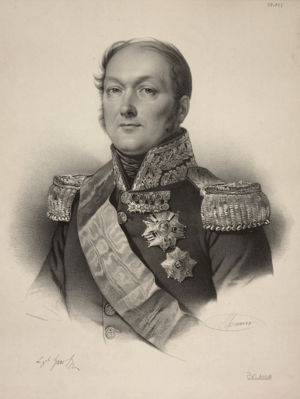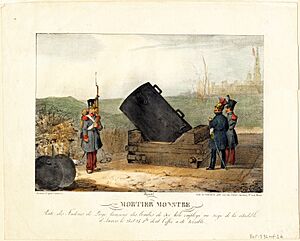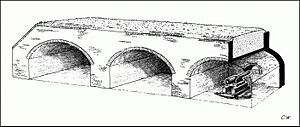François-Nicolas-Benoît Haxo facts for kids
François Nicolas Benoît, Baron Haxo (born June 24, 1774 – died June 25, 1838) was a French general and military engineer. He lived during an exciting time in France, known as the French Revolution and the First French Empire. Haxo became very well known for his work during the Siege of Antwerp in 1832. He was also the nephew of another famous general from that time, Nicolas Haxo.
Contents
Early Life and Military Career
François-Nicolas-Benoît Haxo was born in Lunéville, France. He started his career as a military engineer in 1793. Military engineers design and build things like forts and bridges for armies. Haxo quickly showed he was very good at this job.
He finished the School of Artillery and Engineers in Chalons-sur-Marne in 1793. He became a Lieutenant Minor, which is a junior officer rank. Soon after, in 1794, he became a Captain of Engineers in the Army of the Rhine. In 1796, he went to a special school called École Polytechnique.
In 1801, Haxo became a battalion commander. This happened after the French Army of Italy took over Fort Bard.
Building and Improving Fortifications
Haxo was often called the "Vauban of the nineteenth century." Vauban was a famous French military engineer from the 1600s. Haxo earned this nickname because he was excellent at fixing and making forts stronger.
Forts needed to be improved because guns and cannons became much more powerful. For example, in the 1600s, cannons could not reach the citadel from nearby hills. But by the 1800s, new cannons could easily hit it. Haxo built new forts on these hills to stop enemies from using them to attack.
Serving Napoleon and Beyond
In 1807, Haxo helped make the defenses of Constantinople better. Then he went to Italy to work under General Chasseloup. In 1809, he was promoted to Major. He showed great skill during the Second Siege of Zaragoza.
Napoleon I noticed Haxo's talent and made him a Colonel. Haxo fought in the Battle of Wagram. He then returned to Spain to lead siege operations for General Suchet's army. In 1810, he became a Brigadier General. He also received the title of "baron" in 1811. That same year, he helped prepare German forts for a possible Russian invasion.
In 1812, Haxo was the chief engineer for General Davout's army corps. After the French army's difficult retreat from Moscow, Haxo was promoted again. He became a Division General. In 1813, he commanded the Guard Engineers. He also built defenses around Hamburg, which helped Davout's army hold the city. On August 30, he was wounded and captured during the Battle of Kulm.
After Napoleon's Fall
After Napoleon's rule ended, King Louis XVIII of France wanted Haxo to join the Royal Guards. But Haxo stayed loyal to Napoleon. During the "Hundred Days" when Napoleon returned, Haxo helped build temporary defenses for Paris. He also fought in the famous Battle of Waterloo.
After the king returned to power for a second time, Haxo did some of his best work. As Inspector General, he rebuilt many old forts. These forts had failed during the invasions of 1814 and 1815.
In 1815, the government removed him from the military. But in 1819, he was brought back. He became Inspector General for forts along the borders. These included important places like Grenoble, Besançon, and Belfort.
Later Career and Achievements
Haxo became Inspector General of the Royal Weapon. He also received a very high honor, Grand Officer of the Legion of Honour. In 1832, King Louis Philippe I made him a Peer of France. This meant he was a member of a special council that advised the king. In 1833, he received an even higher honor, the Grand Cross.
Soon after becoming a Peer of France, Haxo took part in the Siege of Antwerp. He led the engineers who attacked the fortress. He was much better than the enemy engineers. The fortress had to surrender after just over three weeks, on December 23, 1832.
After this victory, Haxo was seen as the best military engineer in Europe. He oversaw the building of defenses in many cities. He is also famous for inventing a special type of covered gun position. It was called a Haxo casemate. This design helped protect cannons and their crews.
In his later years, Haxo wrote about military topics. He also wrote a biography of General Dejean. General Haxo passed away in Paris on June 25, 1838.
See also
- Ceintures de Lyon
Sources




